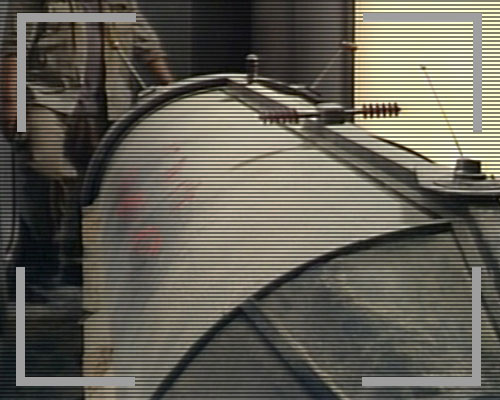You are using an out of date browser. It may not display this or other websites correctly.
You should upgrade or use an alternative browser.
You should upgrade or use an alternative browser.
UNKNOWN ARTIFACT: Signal Fomat Decrypted?
- Thread starter jspoto
- Start date
Whether we are overthinking this or not, whether it's a coded message leading to galactic war, or just a freaky sounding object noone had bothered listening to, this is good for the game. It's good for the galaxy and the community. So even if there's nothing to it, there will be soon. This kind of engagement by the community is, since I've been around, unprecedented. It is an amazing opportunity to unite the entire galaxy under one umbrella: The search for the truth. I, for one, am very thankful that this has happened, and happened the way it did. It has sent such a strong message of some larger things we are capable of when we put our guns up, and our willpower on the communal table. Run with it FD!
This also opened up a freelance sort of salvage for hire industry. Some people want to get their hands on this thing so bad, they are willing to pay millions of credits to gain access to it. Not gonna lie, this is why I spent 2 days searching for it. I fully re-fitted my Vulture for cargo salvage (That's right, SIX tons baby!) and scoured SS's. My intention was to release it to the scientists (Arcannon's team), doubling or tripling my personal assets. Sucks that scooping Palladium is the way payment is received, but it is a fun change of focus while waiting for Powerplay.
It became a kind of an accidental, community organized CG, while FD was on holiday. This is an awesome and unforeseen development in the social engagement of ED, and I am thankful for it. Thanx to everyone involved, and a special thanx to those few that are foaming at the mouth, and skipping sleep trying to figure something out.

This also opened up a freelance sort of salvage for hire industry. Some people want to get their hands on this thing so bad, they are willing to pay millions of credits to gain access to it. Not gonna lie, this is why I spent 2 days searching for it. I fully re-fitted my Vulture for cargo salvage (That's right, SIX tons baby!) and scoured SS's. My intention was to release it to the scientists (Arcannon's team), doubling or tripling my personal assets. Sucks that scooping Palladium is the way payment is received, but it is a fun change of focus while waiting for Powerplay.
It became a kind of an accidental, community organized CG, while FD was on holiday. This is an awesome and unforeseen development in the social engagement of ED, and I am thankful for it. Thanx to everyone involved, and a special thanx to those few that are foaming at the mouth, and skipping sleep trying to figure something out.

Last edited:
Guys, I think I figured it out.
Seriously guys.
I think I have it all figured. It's really obvious when you just blow some dust off it.

I suspect Quagaars involvement.
Seriously guys.
I think I have it all figured. It's really obvious when you just blow some dust off it.

I suspect Quagaars involvement.
Last edited:
Not the decaying chicken monsters! They are more powerful that anything known in the universe!
Haha! Has anyone tried pumping the Space Horn* at the thing?
*Advanced Discovery Scanner
Are we certain that it's Thargoid in origin?
Ozric
Volunteer Moderator
Hello there
Didnt Carl Sagan etc use a numeric math code which all species should decipher if they've reached a certain level of mathmatics on the voyager probe audio disk?
Anyone tried using that algorithm? or is it too obvious?
Rdgs
LoK
I find it a bit odd how we can expect other species to be able to decipher something that is completely unique to our way of thinking.
Can somebody check these at some point for me? I've been through all the sequences we have (ignoring the first one from the video, which is only a partial sequence). The unknown_artefact_audio_long.mp3 is the first one, then UA 1..5.mp3.
011
100100
0010010
1001011
0100101
0110011
1101010
0011010
100101
0110101
0110110
00100
100100
0110101
0100100
1001011
1100110
1010010
1010110
0011001
0110011
0110110
010011
0101011
1011001
0100110
0100101
1001010
1001001
0101011
001001
1100100
1010110
010
11011
100100
011011
110010
010110
010011
100110
0110101
0101100
0110010
1100110
01100
101001
0101100
0011011
1011001
0010010
0010100
0100110
011001
1001011
1010110
00110
0011001
001100
0011010
1010110
0010011
0110110
1001101
1001100
1001011
101001
01101
011010
010101
0101011
1001001
0110010
1010110
101010
0110011
0101001
1101001
I'm not convinced about my results, because there are an awful lot of 6-bit numbers there. However, if we assume that the first entry in any sequence is the header...we have 2, 3, 4, 6, 12, 13 and 19. That means I either missed the first entry off when I recorded a couple of them (unlikely, given that all except one have the same number of entries), or it means we have at least 19 sequences to record.
I did quite a lot of transcribing earlier and also found a lot of 6 bit sequences. Unfortunately I don't have it to hand right now to check against yours. Looking at a spectrogram confirmed there were no additional bits I missed in those short sequences although the there were some where the first and last notes were very quiet or seemed to be cut off.
i did find a number of commonly repeating sequences, especially in the 6 bit segments. I am hoping this is not just coincidence, but it may be. If there is a header or a separator this would be a great find. More recordings are needed, but that is not meaning to pressure you as what you've done so far is great!
i am interested to know more about the circumstances of the recording. Are they from the point the UAs are dropped? Is there any specific trigger to end the recordings? I'm curious as the start always seems a little different to the rest.
Philip Coutts
Volunteer Moderator
I would do what I've always done to things I'm not sure about...run away screaming like a little girl *
* This is in fact an insult to little girls who I am pretty sure are far braver than me.
* This is in fact an insult to little girls who I am pretty sure are far braver than me.
I would do what I've always done to things I'm not sure about...run away screaming like a little girl *
* This is in fact an insult to little girls who I am pretty sure are far braver than me.
I'm pretty sure some will try to ram it.
Philip Coutts
Volunteer Moderator
.I'm pretty sure some will try to ram it.
Does anyone remember the Star Trekin' spoof song from years ago? There is a line in it which is probably suitable and that is:
.
"We come in peace, shoot to kill"
So, the things I noticed was that the "pips" come at two different frequencies, high and low, but they come at a distinct interval, separated by pauses.
The "pips" were in groups of 7, but one of the groups only had 6.
The "poops" are syncopated with the "pips" and don't match up.
Are the "poops" coming at equal intervals as well, like the "pips"?
What is the ratio of the speed of the two sounds?
What is the frequency difference between the two 'pips'?
Is the 200% speed recording I heard on PCGamer the full recording we have?
I looked at at the timings a bit earlier. They are not perfect, but are close. The volumes of the honks also change quite significantly, especially on the first and last honks of a sequence. The gaps seem to differ most based on whether it is high or low pitches that are being produced with the start of a low pitched honks having a longer gap from the start of the previous honk than a high pitched honk.
I was hoping it would be possible to flag the exact points honks would be expected, but this is not the case. The different sounds that are being produced are not in time with each other the alternating whale song sounds are not in time with the honks - this is why they sometimes overlap and are difficult to hear.
I am am also intrigued by the period of quiet clicks and scrapes generally between the whale song and the honk. I have not had chance to consider this much yet though.
Ha, this sounds like the original Elite being loaded via cassette.And here's an alternative approach - instead of speeding the audio up, shift the pitch up (transpose upwards) while maintaining the same playback speed.
Something like this: https://www.dropbox.com/s/opekevrqtwjhq7g/UA_transposed.mp3?dl=0
based on the original recording from: http://www.digitalscream.org.uk/audio/unknown_artifact_audio.mp3
Sounds rather more data-like and less tuba-like. Back to RL work now.
Last edited:
I looked at at the timings a bit earlier. They are not perfect, but are close. The volumes of the honks also change quite significantly, especially on the first and last honks of a sequence. The gaps seem to differ most based on whether it is high or low pitches that are being produced with the start of a low pitched honks having a longer gap from the start of the previous honk than a high pitched honk.
I was hoping it would be possible to flag the exact points honks would be expected, but this is not the case. The different sounds that are being produced are not in time with each other the alternating whale song sounds are not in time with the honks - this is why they sometimes overlap and are difficult to hear.
I am am also intrigued by the period of quiet clicks and scrapes generally between the whale song and the honk. I have not had chance to consider this much yet though.
I didn't notice the scrapes and clicks! I wonder if slowing the recording down would expose something in there. I guess what I'm looking for is some mathematically significant key which will replace primes or what-have-you. I was thinking PHI the golden ratio, which is why I asked about the ratios between intervals and frequencies.
Obviously it's going to be up to das uber brainz to pick things apart, but it's not beyond one of us to ask the right questions.
.
Does anyone remember the Star Trekin' spoof song from years ago? There is a line in it which is probably suitable and that is:
.
"We come in peace, shoot to kill"
Scotty beam me up

